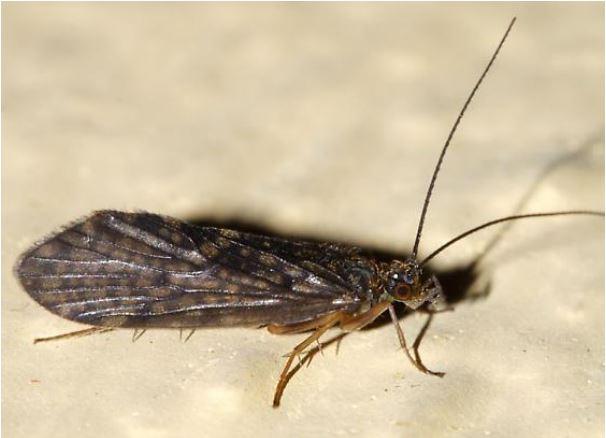Moderate
The population size and trend of Rhyacophila pichaca is unknown in Washington.
Caddisflies are aquatic insects. They are very sensitive to water quality and changes in water flow. Caddisflies in general are often considered an indicator of high-quality streams, suggesting that they are particularly vulnerable to changes in their habitat.
Description and Range
Physical description
Caddisflies are closely related to the Lepidoptera (moths and butterflies). The adult’s body and wings are covered with long silky hairs (setae) – a distinctive characteristic of the order. Caddisflies are aquatic in the immature stages.
Ecology and life history
This species inhabits depositional areas of streams and large springs in mid- and high-altitude localities.
During the day, adults hide in cool, moist environments such as the vegetation along riverbanks. Few caddisfly adults have actually been observed feeding; they imbibe nectar.
Adults live several weeks and usually mate on vegetation or rocks surrounding water. Eggs, in masses numbering up to 800, are laid within a jelly that swells on contact with water. A female may wash off a partially extruded egg mass by dipping her abdomen into water during flight, or she may place the mass on stones in the water or on aquatic plants just above the water. Young larvae hatch within a few days and progress through multiple instars before emerging as a winged adult.
Although most larvae feed on aquatic plants, algae, diatoms, or plant debris, a few are predatory on other aquatic insects, crustaceans, and mollusks, and a few are omnivorous. The larvae play an important role in the aquatic community, reducing plant growth and disposing of animal and plant debris.
Caddisfly adults sometimes emerge in large numbers, often forming swarms. Adults tend to remain somewhat near the emergence site where oviposition occurs. They tend to disperse shorter distances in dense forest compared with more open vegetation. Although dispersal flights are common, such flights are relatively short and only occur immediately following emergence.
Geographic range
This species is recorded from Olympic Hot Springs, Boulder Lake, Washington, Clallam County. Also known from Cascade Head Experimental Forest, Tillamook County, near Otis, Oregon.
For a map of worldwide distribution and conservation status of this species, check out NatureServe Explorer.
Climate vulnerability
Sensitivity to climate change
Moderate
Rhyacophila pichaca is an uncommon species of caddisfly found in only a few locations in Washington and Oregon. Little is known about this species, but caddisflies in the genus Rhyacophila are fairly large and are free-living in their larval stage (i.e. they do not build cases until the pupae stage), making them particularly vulnerable to predation. All species in this genus are restricted to streams or rivers in the larval and pupae stages, though no information is available on whether this species is restricted to cold water or high-elevation areas. Given that they are dependent on running water, it is likely that drought, changes in precipitation patterns, and low summer flows contribute to this species' sensitivity. Caddisflies in general are often considered an indicator of high-quality streams, suggesting that they are may be vulnerable to changes in their habitat.
Exposure to climate change
Moderate
- Changes in precipitation
- Drought
- Low summer flows
Conservation
Conservation Threats and Actions Needed
- Resource information collection needs
- Threat: Lack of data on current status and distribution
- Action Needed: Determine distribution and population status
- Fish and wildlife habitat loss or degradation
- Threat: Water quality is of extreme importance to aquatic insects
- Action Needed: Protect riparian habitats
- Climate and severe weather
- Threat: Drying of streams
- Action Needed: Determine distribution and population status
See the Climate vulnerability section for more information about the threats posed by climate change to this species.
Resources
References
Clemson University Department of Entomology (J.C. Morse, ed.). 2002. Last Updated 5 September 2006. Trichoptera World Checklist. Online. Available: http://entweb.clemson.edu/database/trichopt/index.htm.
Denning, D. G. 1956. Several new species of western Trichoptera. Pan-Pacific Entomologist 32(2):73-80.
NatureServe. 2014. NatureServe Explorer: An online encyclopedia of life [web application]. Version 7.1. NatureServe, Arlington, Virginia. Available http://explorer.natureserve.org.
Ruiter, D. E., B. C. Kondratieff, R. A. Lechleitner, and R. E. Zuellig. 2005. An annotated list of the caddisflies (Trichoptera) of Mt. Rainier National Park, Washington, USA. Transactions of the American Entomological Society 131(1/2): 159-187.
Rasmussen, A. K., and J. C. Morse. 2020. Distributional checklist of Nearctic Trichoptera (Fall 2020 Revision). Unpublished, Florida A&M University, Tallahassee. 517 pp
Wold, J. L. 1974. Systematics of the genus Rhyacophila (Trichoptera: Rhyacophilidae) in western North America with special reference to the immature stages. M.S. thesis, Oregon State Univ., Corvallis.
D. Ruiter, pers.comm.
